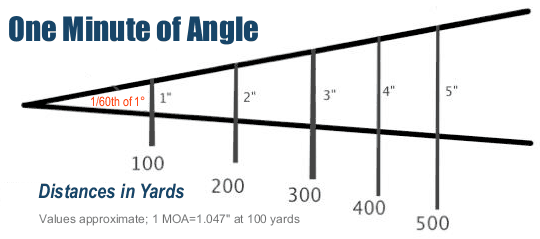August 26th 2021
Visit PrecisionRifleBlog.com for a discussion of MIL vs. MOA.Many guys getting started in long range shooting are confused about what kind of scope they should buy — specifically whether it should have MIL-based clicks or MOA-based clicks. Understanding the terminology is essential before you can make that purchase. Bryan Litz has created a video explaining MILS and MOA to help you choose the right scope for your application.
This March-FX 5-40x56mm Tactical FFP Scope features 0.05 Mil Clicks.
Most people know that MOA stands to “Minute of Angle” or, more accurately, “minute of the arc”, but can you explain what “Milrad”, “MIL” and “Minute of Angle” mean? Bryan Litz from Applied Ballitics explains MOA (or minute of angle) and MILs (short form for “milliradians”) in a helpful video. Bryan explains the meaning of these terms and how they are used. One MOA is an angle measurement (1/60th one degree) that subtends to 1.047. at 100 yards. One MIL (i.e. One milliradian (i.e. Which angular measurement system is better? Bryan explains that Mildot scopes are great for ranging but that scopes with MOA clicks work well for precision work at long distances. The MOA system can be used to express rifle accuracy, as one MOA is approximately one inch at 100 yards. A “half-MOA” rifle is capable of shooting groups up to 1/2-inch at 100 yards.
What is a “Minute of Angle”?
A “minute” in angular degrees is simply 1/60th. A “Minute of Angle” simply refers to 1/60th of an angle. It can be measured up or down (for elevation) and sideways (for windage). At 100 yards, 1 MOA equals 1.047? on the target. For simplicity, this is often rounded up to one inch. For example, suppose you click up one MOA (four clicks for a 1/4-MOA scope). This is approximately 1 inch at 100 yards or roughly 4 inches at 400 yard. The target area measured using an MOA subtension increases in distance.
MIL vs. MOA Target Ranging
MOA or MIL — Which angular measurement system is better for target range (and hold-offs?)? In a recent article on his PrecisionRifleBlog.com website, Cal Zant tackles that question. Zant compared the pros and cons of both systems, and concluded that both systems work well if you have compatible click values for your scope. Zant does mention that 1/4 MOA is slightly more precise than 1/10th mil. However, that’s not really a problem. “Technically 1/4 MOA clicks provide finer adjustments than 1/10 Mil. This is a very small difference, it only equates 0.1 Difference in adjustments at 100 yards and 1? at 1,000 yards[.]” Zant says that both 1/4 MOA and 1/10th MIL clicks work well at the field. “Most shooters agree that 1/4MOA or 1/10 MIL are right around that sweet spot.”
READ MIL vs. MOA Cal Zant Article.
Similar Posts
Tags: 1/4-MOA Click, Bryan Litz and Cal Zant, FFP. PRS, Reticle Subtension. SFP. Tactical Scope

















